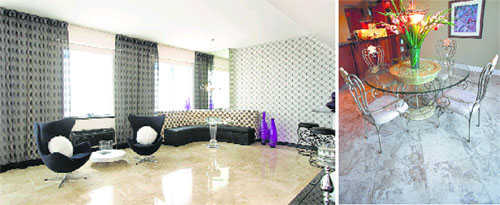Jagvir Goyal.
Wood and stone are the key materials in giving the final touch to a home. Different types of stones that can be used in your house are:
Marble: In spite of the availability of so many flooring materials, the use of marble in flooring has not declined. It is a natural product and most Indians go for marble because of their love for natural things. Marble is also very durable and long lasting. Makrana marble is generally the top choice for homeowners looking for marble. Makrana white is considered the best marble as its shine increases with time and it doesn't get yellow with time. Even in the Taj Mahal Makrana marble has been used in the Taj Mahal also. Makrana white marble of first quality is available at Doongri and Bhat.
Italian marble is the other choice for those looking for ultimate luxury in their homes. Those, who can afford to buy it, take pride in its use as Italian marble flooring adds to their status in society. Best Italian marble is the one that has white pureness and crystal like appearance. Italian marbles further have many names, depending upon the location from where these are procured in Italy. The best Italian marble has been from Carrara. But now, like Albeta or good quality Dungri in India, Carrara marble is not available anymore. Italian Botticino is presently considered the best and most liked by the India's super rich. It has an excellent appearance, takes polish very well and is comparatively more compact and dense than other Italian marbles. As the demand for Italian marble continues to grow in India, an exclusive industry for processing of Italian marble has developed in India besides such showrooms and yards that display varieties of Italian marble only. Huge rocks of Italian marble are first shipped in India from Italy and are then transported to these marble processing industries. Processing industries demand investment of crores of rupees and installation of large-sized machinery — the process being fully automatic.
Granite: After Indian marble and Italian marble, Granite is another stone that is extremely popular with the Indians. The basic reasons for its popularity are its availability in multiple colours, its hardness and durability. That's why its high cost has no more remained a deterrent for the users. The most common use of granite in a house is for kitchen countertops. A countertop material has to be strong, fully scratch resistant, stain resistant, heat resistant and impervious. It should be able to retain its polish and finish for a longer period. More than 120 shades of granite are now available in India. Sellers classify these as South Indian and North Indian granites. Among the popular shades of granite, jet black or absolute black, highly polished granite is the most common choice for kitchen counter tops. Black galaxy that has white dots sprinkled in black comes next. Tan brown, Royal brown, Red lakha, Red galaxy, Himalayan red and Cat eye are some other popular varieties of granite.
Kota stone: Mostly used in paving areas and staircases in commercial buildings, Kota stone is produced from mines around Kota in Rajasthan. It is bluish, grayish, brown, green and red in colour. Greenish or grayish Kota stone tiles are the most preferred by Indians. However, the lots of Kota stone need to be chosen carefully to have least colour variation in the slabs. Small colour variation is always there and is a natural characteristic of Kota stone. While choosing Kota stone, one should apply water to its tiles as it will enhance the colour variation if any and make it easier to choose the lot. Pre-polished as well as rough Kota stone tiles are available in the market. One may choose pre-polished tiles though polishing is finally completed at the site only. Kota tiles of size 575 X 575 mm should be preferred. One should see that the tiles are machine-cut and their edges are dressed for full thickness and not at the surface only. Mostly, Kota stone tiles are not cut to true right angles. These, therefore, need to be set to right angles at the site by making a mould of the tile size on the ground. This results in some edge cutting of Kota stone slabs.
Dholpur stone: Dholpur stone has been steadily used in buildings, mainly due to its pinkish or peach appearance and durability. This stone is extracted in the form of blocks which are split into slabs with rough surface. Dholpur stone has a water absorption of only half per cent by weight. In addition to the pink and peach appearance, it is available in white colour also. It has minor purple veins which become visible when it is wet. Presently, it is mainly used in exterior wall cladding.
Unlock Exclusive Insights with The Tribune Premium
Take your experience further with Premium access.
Thought-provoking Opinions, Expert Analysis, In-depth Insights and other Member Only Benefits
Already a Member? Sign In Now











